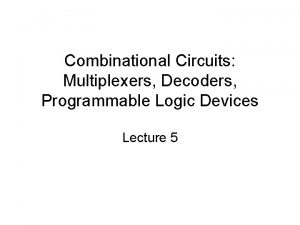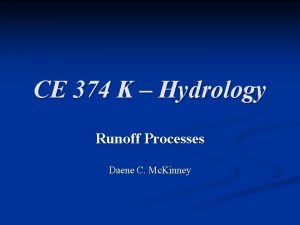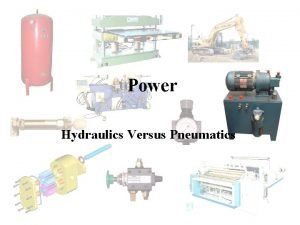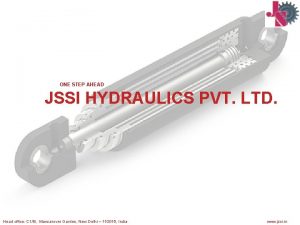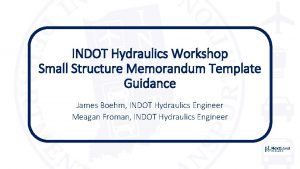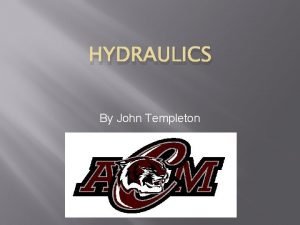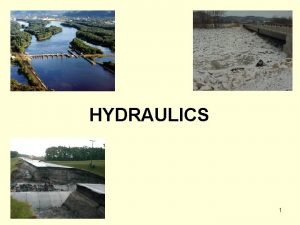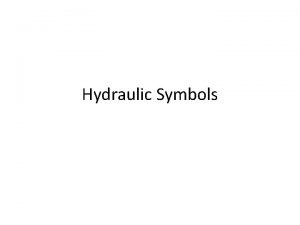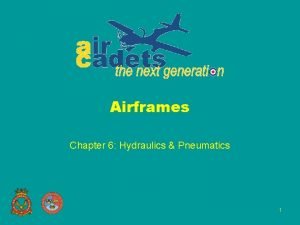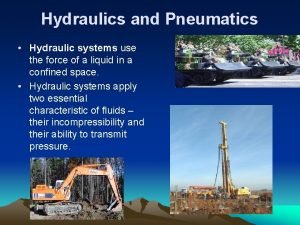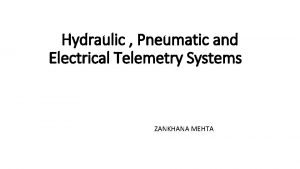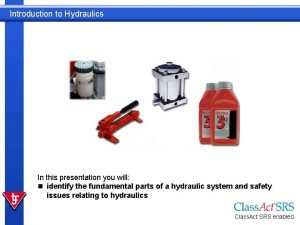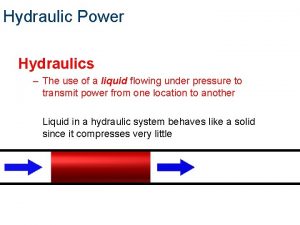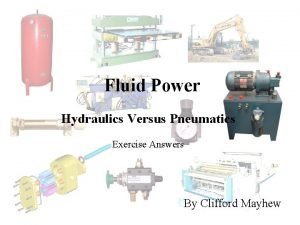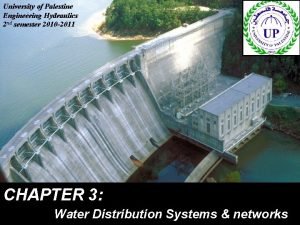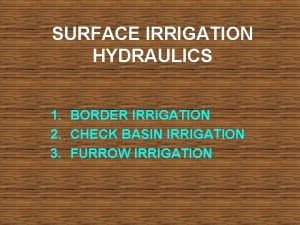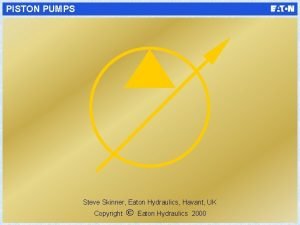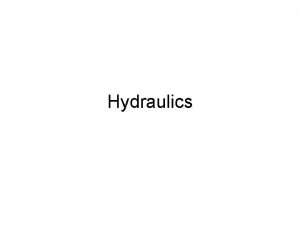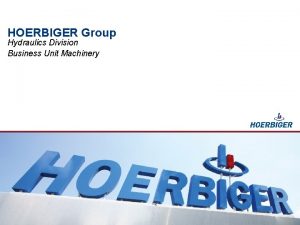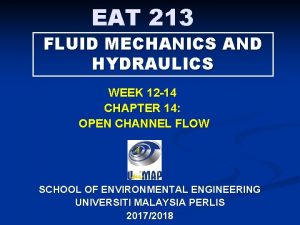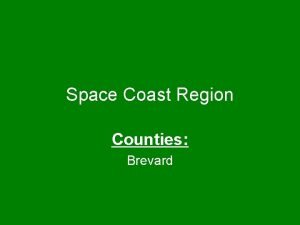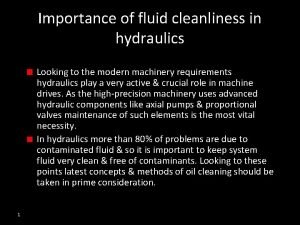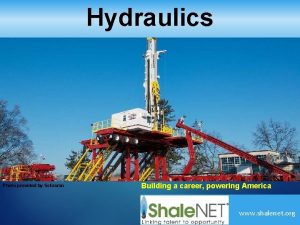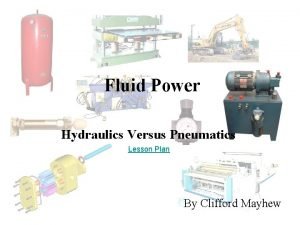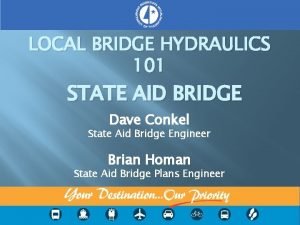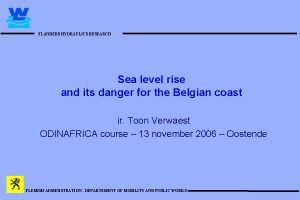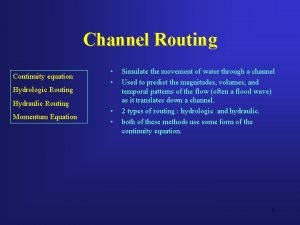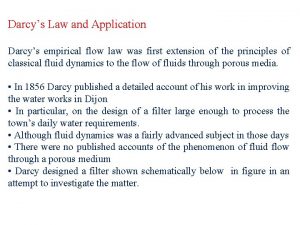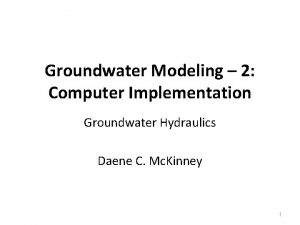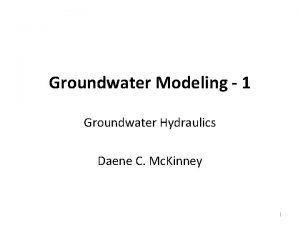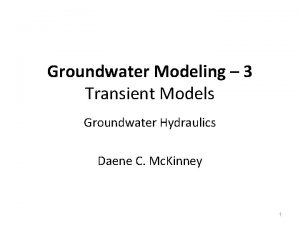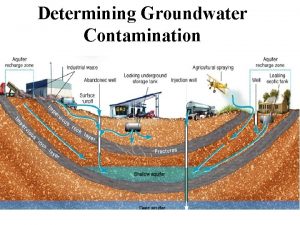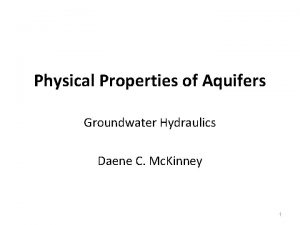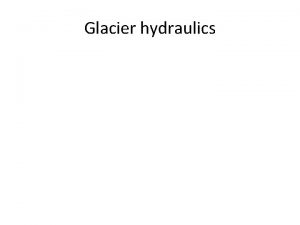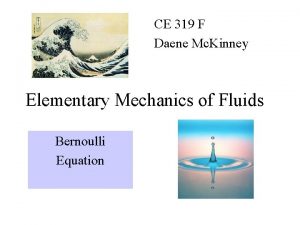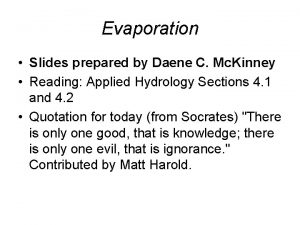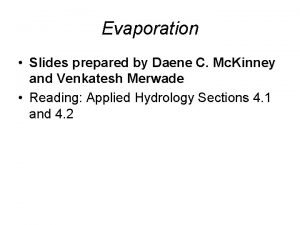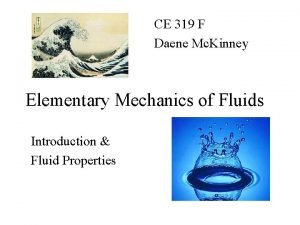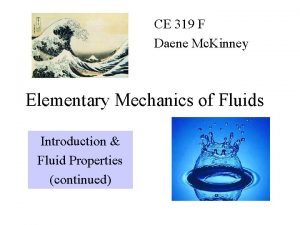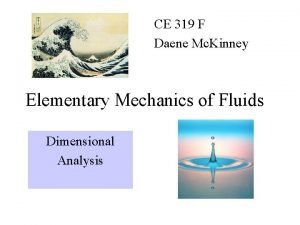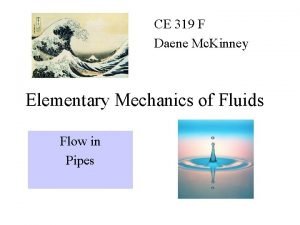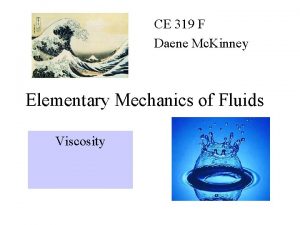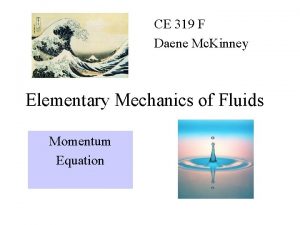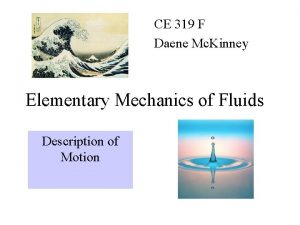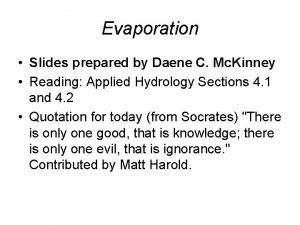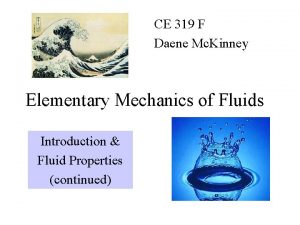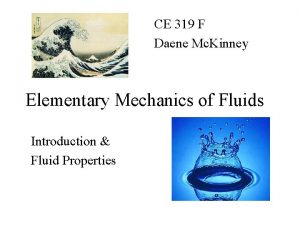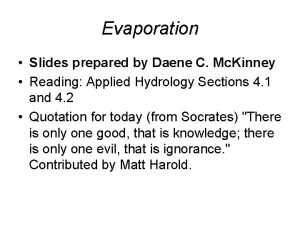Darcys law Groundwater Hydraulics Daene C Mc Kinney





![Hydraulic Conductivity • Has dimensions of velocity [L/T] • A combined property of the Hydraulic Conductivity • Has dimensions of velocity [L/T] • A combined property of the](https://slidetodoc.com/presentation_image_h2/4171f0e680d46aafcaccf22d992710c1/image-6.jpg)

































- Slides: 39

Darcy’s law Groundwater Hydraulics Daene C. Mc. Kinney 1

Outline • • • Darcy’s Law Hydraulic Conductivity Heterogeneity and Anisotropy Refraction of Streamlines Generalized Darcy’s Law 2

Darcy http: //biosystems. okstate. edu/Darcy/English/index. htm 3

Darcy’s Experiments • Discharge is Proportional to – Area – Head difference Inversely proportional to – Length • Coefficient of proportionality is K = hydraulic conductivity 4

Darcy’s Data 5
![Hydraulic Conductivity Has dimensions of velocity LT A combined property of the Hydraulic Conductivity • Has dimensions of velocity [L/T] • A combined property of the](https://slidetodoc.com/presentation_image_h2/4171f0e680d46aafcaccf22d992710c1/image-6.jpg)
Hydraulic Conductivity • Has dimensions of velocity [L/T] • A combined property of the medium and the fluid • Ease with which fluid moves through the medium k ρ µ g = cd 2 = = = intrinsic permeability density dynamic viscosity specific weight Porous medium property Fluid properties 6

Hydraulic Conductivity 7

Groundwater Velocity • q - Specific discharge Discharge from a unit crosssection area of aquifer formation normal to the direction of flow. • v - Average velocity of fluid flowing per unit crosssectional area where flow is ONLY in pores. 8

Example h 1 = 12 m K = 1 x 10 -5 m/s f = 0. 3 Find q, Q, and v h 2 = 12 m /” 10 m Flow Porous medium 5 m L = 100 m dh = (h 2 - h 1) = (10 m – 12 m) = -2 m J = dh/dx = (-2 m)/100 m = -0. 02 m/m q = -KJ = -(1 x 10 -5 m/s) x (-0. 02 m/m) = 2 x 10 -7 m/s Q = q. A = (2 x 10 -7 m/s) x 50 m 2 = 1 x 10 -5 m 3/s v = q/f = 2 x 10 -7 m/s / 0. 3 = 6. 6 x 10 -7 m/s 9

Hydraulic Gradient vector points in the direction of greatest rate of increase of h Specific discharge vector points in the opposite direction of h 10

Well Pumping in an Aquifer Hydraulic gradient y Circular hydraulic head contours Dh K, conductivity, Is constant q Specific discharge x Well, Q h 1 h 2 h 3 h 1 < h 2 < h 3 Aquifer (plan view) 11

Validity of Darcy’s Law • We ignored kinetic energy (low velocity) • We assumed laminar flow • We can calculate a Reynolds Number for the flow q = Specific discharge d 10 = effective grain size diameter • Darcy’s Law is valid for NR < 1 (maybe up to 10) 12

Specific Discharge vs Head Gradient Re = 10 Re = 1 Experiment shows this Darcy Law predicts this a tan-1(a)= (1/K) q 13

Estimating Conductivity Kozeny – Carman Equation • Kozeny used bundle of capillary tubes model to derive an expression for permeability in terms of a constant (c) and the grain size (d) Kozeny – Carman eq. • So how do we get the parameters we need for this equation? 14

Measuring Conductivity Permeameter Lab Measurements • Darcy’s Law is useless unless we can measure the parameters • Set up a flow pattern such that – We can derive a solution – We can produce the flow pattern experimentally • Hydraulic Conductivity is measured in the lab with a permeameter – Steady or unsteady 1 -D flow – Small cylindrical sample of medium 15

Measuring Conductivity Constant Head Permeameter • Flow is steady • Sample: Right circular cylinder – Length, L – Area, A Continuous Flow head difference • Constant head difference (h) is applied across the sample producing a flow rate Q flow • Darcy’s Law Overflow A Outflow Q Sample 16

Measuring Conductivity Falling Head Permeameter • Flow rate in the tube must equal that in the column Initial head Final head flow Outflow Q Sample 17

Heterogeneity and Anisotropy • Homogeneous – Properties same at every point • Heterogeneous – Properties different at every point • Isotropic – Properties same in every direction • Anisotropic – Properties different in different directions • Often results from stratification during sedimentation www. usgs. gov 18

Example • • a = ? ? ? , b = 4. 673 x 10 -10 m 2/N, g = 9798 N/m 3, S = 6. 8 x 10 -4, b = 50 m, f = 0. 25, Saquifer = gabb = ? ? ? Swater = gbfb • % storage attributable to water expansion • • %storage attributable to aquifer expansion • 19

Layered Porous Media (Flow Parallel to Layers) Piezometric surface Dh h 1 h 2 datum Q b W 20

Layered Porous Media (Flow Perpendicular to Layers) Piezometric surface Dh 1 Dh 2 Dh Dh 3 b Q Q L 1 L 2 L L 3 21

Example Flow Q • Find average K 22

Flow Q Example • Find average K 23

Anisotrpoic Porous Media • General relationship between specific discharge and hydraulic gradient 24

Principal Directions • Often we can align the coordinate axes in the principal directions of layering • Horizontal conductivity often order of magnitude larger than vertical conductivity 25

Flow between 2 adjacent flow lines For the squares of the flow net so For entire flow net, total head loss h is divided into n squares If flow is divided into m channels by flow lines 26

KU/KL = 1/50 Flow lines are perpendicular to water table contours Flow lines are parallel to impermeable boundaries KU/KL = 50 27

Contour Map of Groundwater Levels • Contours of groundwater level (equipotential lines) and Flowlines (perpendicular to equipotiential lines) indicate areas of recharge and discharge 28

Groundwater Flow Direction • Water level measurements from three wells can be used to determine groundwater flow Head Gradient, J direction Groundwater Contours hi h 1(x 1, y 1) hi > h j > h k hj hk h 3(x 3, y 3) z y Groundwater Flow, Q h 2(x 2, y 2) x 29

Groundwater Flow Direction Head gradient = Magnitude of head gradient = Angle of head gradient = 30

Groundwater Flow Direction Head Gradient, J h 1(x 1, y 1) Equation of a plane in 2 D 3 points can be used to define a plane h 3(x 3, y 3) z y Groundwater Flow, Q h 2(x 2, y 2) x Set of linear equations can be solved for a, b and c given (xi, hi, i=1, 2, 3) 31

Groundwater Flow Direction Negative of head gradient in x direction Negative of head gradient in y direction Magnitude of head gradient Direction of flow 32

Example Find: y Well 2 (200 m, 340 m) 55. 11 m Well 1 (0 m, 0 m) 57. 79 m Magnitude of head gradient Direction of flow x Well 3 (190 m, -150 m) 52. 80 m 33

Example Well 2 (200, 340) 55. 11 m x Well 1 (0, 0) 57. 79 m q = -5. 3 deg Well 3 (190, -150) 52. 80 m 34

Refraction of Streamlines • Vertical component of velocity must be the same on both sides of interface y Upper Formation x • Head continuity along interface Lower Formation • So 35

Consider a leaky confined aquifer with 4. 5 m/d horizontal hydraulic conductivity is overlain by an aquitard with 0. 052 m/d vertical hydraulic conductivity. If the flow in the aquitard is in the downward direction and makes an angle of 5 o with the vertical, determine q 2. 36

Summary • Properties – Aquifer Storage • Darcy’s Law – – Darcy’s Experiment Specific Discharge Average Velocity Validity of Darcy’s Law • Hydraulic Conductivity – – Permeability Kozeny-Carman Equation Constant Head Permeameter Falling Head Permeameter • Heterogeneity and Anisotropy – Layered Porous Media • Refraction of Streamlines • Generalized Darcy’s Law 37

Example Flow Q 38

Flow Q Example 39
 Darcy's law units
Darcy's law units Rebecca kinney
Rebecca kinney Ridley metodu
Ridley metodu Kinney encoder
Kinney encoder Kinney philippines
Kinney philippines Kinney metodu
Kinney metodu Fine kinney method
Fine kinney method Newton's first law and second law and third law
Newton's first law and second law and third law Si unit of newton's first law
Si unit of newton's first law Boyles law
Boyles law Avogadro's law constant
Avogadro's law constant Hydraulic versus pneumatic
Hydraulic versus pneumatic Jssi hydraulics pvt. ltd
Jssi hydraulics pvt. ltd Indot hydraulics
Indot hydraulics Hydraulics definition
Hydraulics definition Hydraulics definition
Hydraulics definition Unidirectional pump symbol
Unidirectional pump symbol Storehouse with fluid tanks
Storehouse with fluid tanks Hydraulics & pneumatics
Hydraulics & pneumatics Hydraulics vs pneumatics
Hydraulics vs pneumatics Pneumatic telemetry system
Pneumatic telemetry system Introduction to hydraulics and pneumatics
Introduction to hydraulics and pneumatics Hydraulics
Hydraulics Pump exercise
Pump exercise Palestine hydraulics
Palestine hydraulics Check basin irrigation advantages and disadvantages
Check basin irrigation advantages and disadvantages Eaton havant
Eaton havant Hydraulics
Hydraulics Hoerbiger hydraulic
Hoerbiger hydraulic Hydraulics
Hydraulics Space coast hydraulics
Space coast hydraulics Fluid cleanliness system
Fluid cleanliness system Professional hydraulics
Professional hydraulics Give the standard graphical symbols for frl unit
Give the standard graphical symbols for frl unit Karl visser
Karl visser Hydraulics 101
Hydraulics 101 Khan academy sat
Khan academy sat Flanders hydraulics research
Flanders hydraulics research Hydrologic continuity equation
Hydrologic continuity equation Continuity equation hydrology
Continuity equation hydrology



